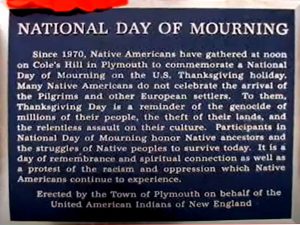
Installed at Plymouth, Massachusetts, in 1921 to commemorate the tercentenary of the landing of the Pilgrims, Cyrus Dallin’s statue Massasoit was intended to memorialize the Pokanoket Massasoit (leader) as a welcoming diplomat and participant in the mythical first Thanksgiving. But after the statue’s unveiling, Massasoit began to move and proliferate in ways one would not expect of generally stationary monuments tethered to place.
Colonial Society of Massachusetts president and Professor of History at Suffolk University Bob Allison introduced Professor O’Brian for a 53-minute presentation that was recorded on YouTube on April 14, 2021.
The plaster model of Dallin’s statue of the Massasoit was donated to the artist’s home state of Utah and prominently displayed in the state capitol; half a century later, it was caught up in a surprising case of fraud in the fine arts market. Versions of the statue now stand on Brigham Young University’s campus; at an urban intersection in Kansas City, Missouri; and in countless homes around the world in the form of souvenir statuettes. In this video, Author Jean O’Brian went on to talk about the process of creating, commodifying, and reinforcing the historical memory of Indigenous people as was portrayed in the Colonial House television series.
(Above) A plaque near the Dallin statue in Plymouth commemorates the National Day of Mourning , and a protest sign is displayed near an art installation in Minneapolis that depicted a gallows. The actual Massasoit and the mythic version of his collaboration with the Pilgrims, shows otherwise hidden dimensions of American memorial culture: an elasticity of historical imagination, a tight-knit relationship between consumption and commemoration, and the twin impulses to sanitize, and to grapple with, the meaning of settler-colonialism.
Click here for an earlier talk by Professor O’Brian






